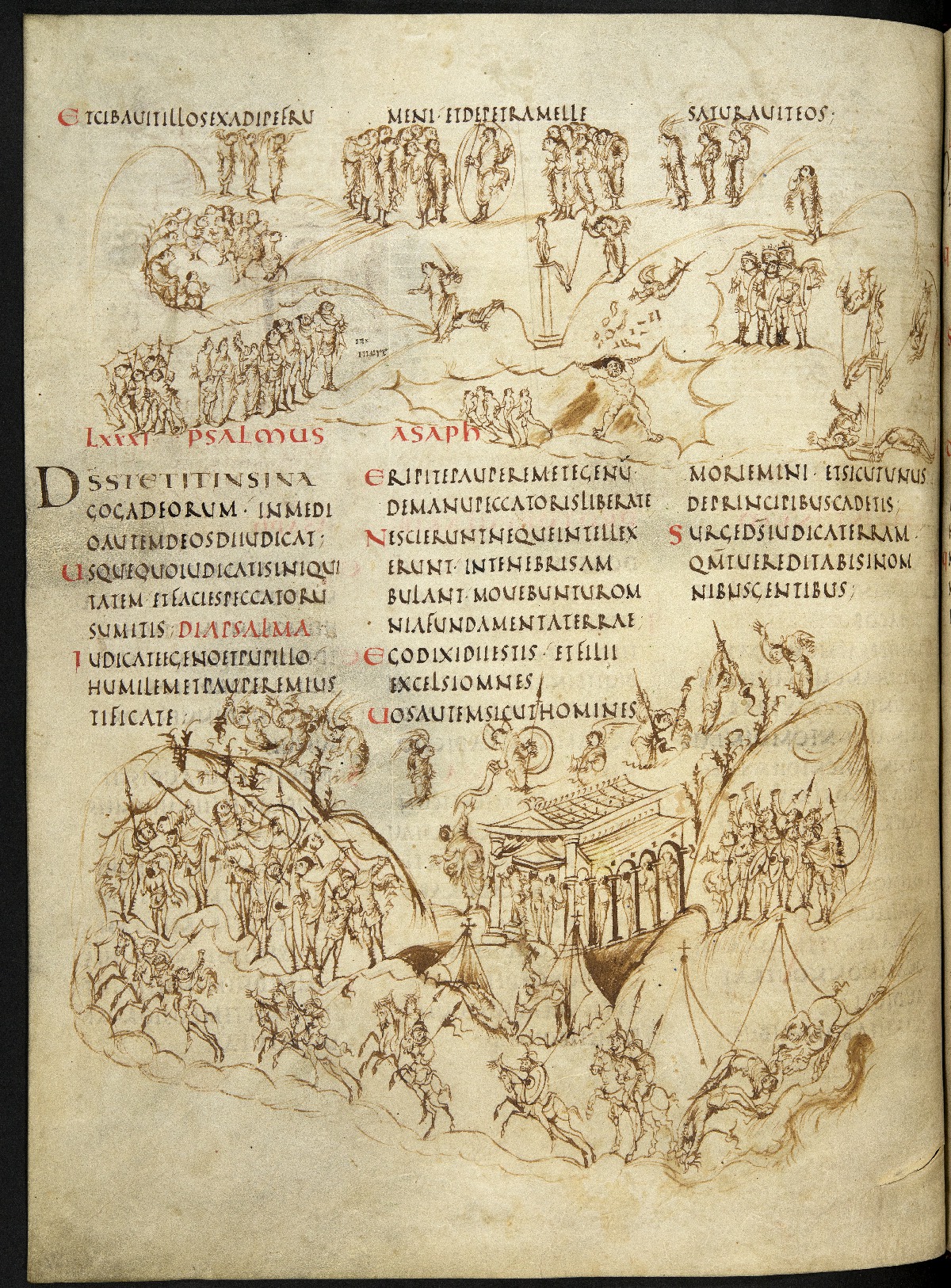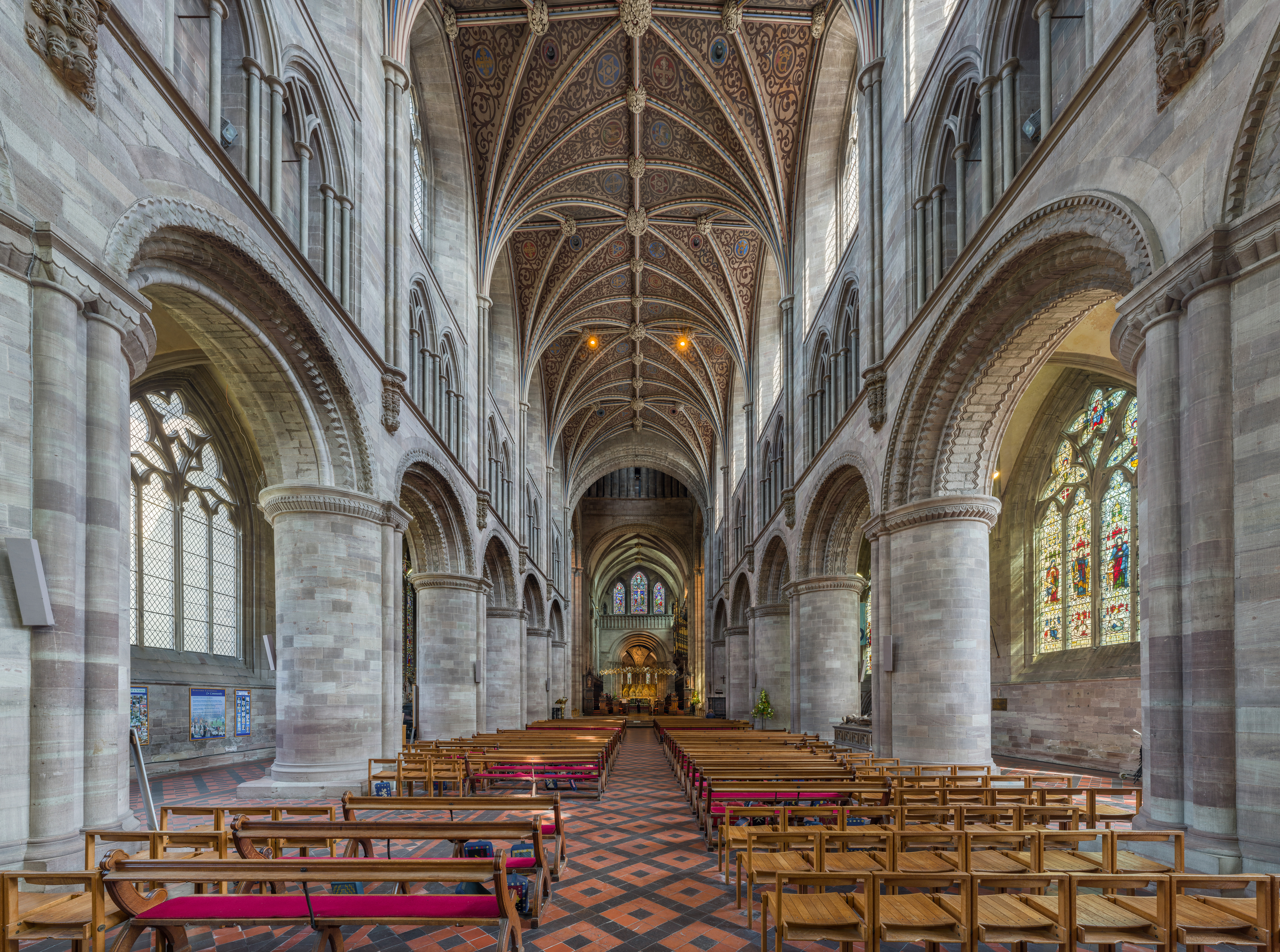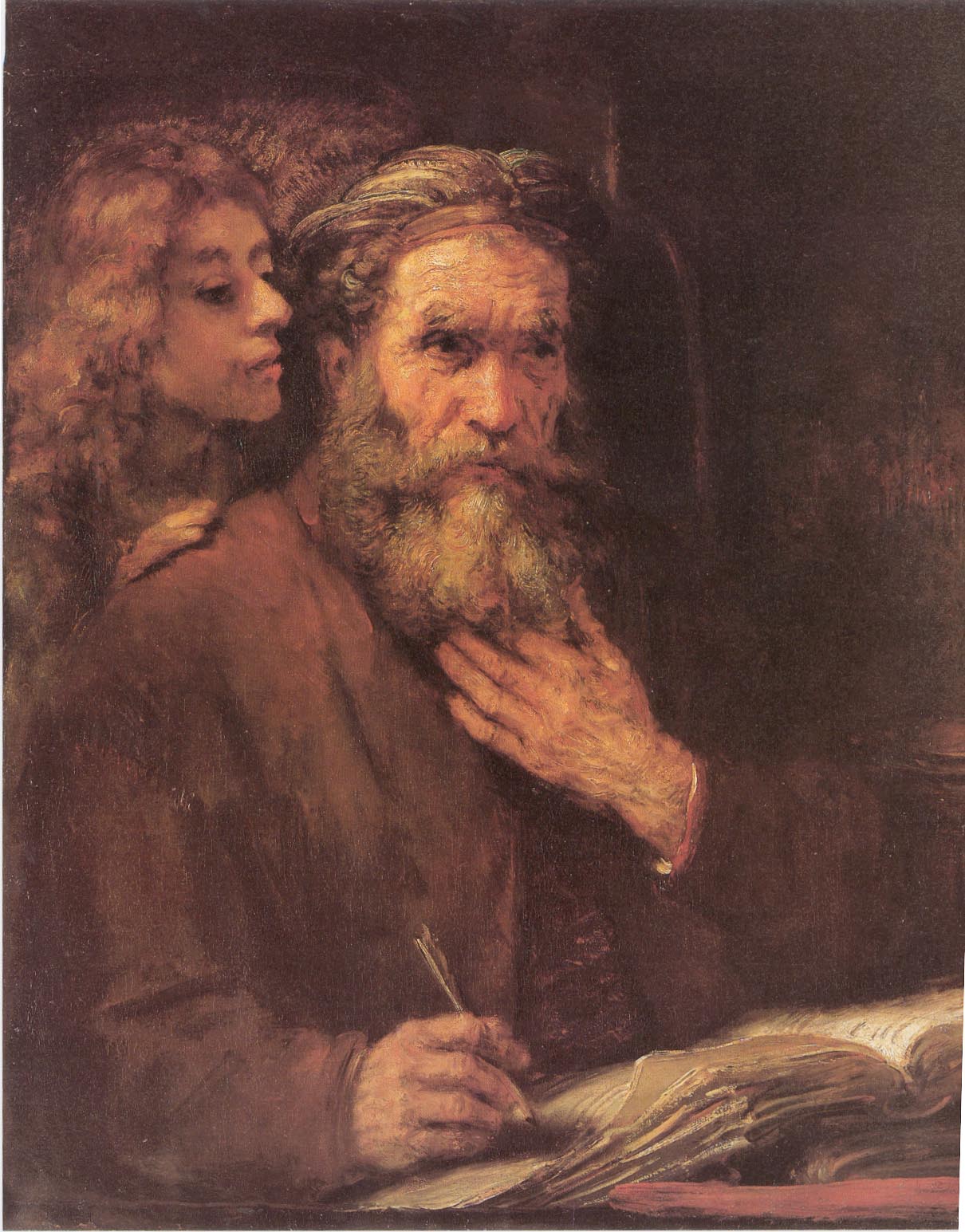|
Psalm 18
Psalm 18 is the 18th psalm of the Book of Psalms, beginning in English in the King James Version: "I love you, O LORD, my strength.". In the Greek Septuagint and the Latin Vulgate, it is psalm 17 in a slightly different numbering system, known as "Diligam te Domine fortitudo mea". It is almost identical to 2 Samuel 22, although verse 1 of the psalm, ''I love you, O LORD, my strength'', is not included in the Samuel version. With 50 verses, this is the longest psalm in Book 1 of the Book of Psalms (Psalms 1-41). The psalm forms a regular part of Jewish, Catholic, Lutheran, Anglican and other Protestant liturgies. It was set to music by composers such as Heinrich Schütz. Text King James Version This psalm, in the English Standard Version, reads in the King James Version: Introduction: The LORD Is My Rock and My Fortress To the choirmaster. A Psalm of David, the servant of the LORD, who addressed the words of this song to the LORD on the day when the LORD rescued him from the h ... [...More Info...] [...Related Items...] OR: [Wikipedia] [Google] [Baidu] |
Utrecht Psalter
The Utrecht Psalter (Utrecht, Universiteitsbibliotheek, MS Bibl. Rhenotraiectinae I Nr 32.) is a ninth-century illuminated psalter which is a key masterpiece of Carolingian art; it is probably the most valuable manuscript in the Netherlands. It is famous for its 166 lively pen illustrations, with one accompanying each psalm and the other texts in the manuscript (Chazelle, 1055). The precise purpose of these illustrations, and the extent of their dependence on earlier models, have been matters of art-historical controversy. The psalter spent the period between about 1000 to 1640 in England, where it had a profound influence on Anglo-Saxon art, giving rise to what is known as the "Utrecht style". It was copied at least three times in the Middle Ages. A complete facsimile edition of the psalter was made in 1875 (Lowe, 237), and another in 1984 (Graz). The other texts in the book include some canticles and hymns used in the office of the hours, including various canticles, the Te D ... [...More Info...] [...Related Items...] OR: [Wikipedia] [Google] [Baidu] |
Messiah In Judaism
The Messiah in Judaism () is a savior and liberator figure in Jewish eschatology, who is believed to be the future redeemer of the Jewish people. The concept of messianism originated in Judaism, and in the Hebrew Bible a messiah is a king or High Priest of Israel traditionally anointed with holy anointing oil. However, messiahs were not exclusively Jewish, as the Hebrew Bible refers to Cyrus the Great, king of the first Persian empire, as a messiah for his decree to rebuild the Jerusalem Temple. In Jewish eschatology, the Messiah is a future Jewish king from the Davidic line, who is expected to be anointed with holy anointing oil and rule the Jewish people during the Messianic Age and world to come. The Messiah is often referred to as "King Messiah" ( he, מלך משיח, translit=melekh mashiach) or in Aramaic. Jewish messianism gave birth to Christianity, which started as a Second Temple period messianic Jewish sect or religious movement. Etymology In Jewish eschato ... [...More Info...] [...Related Items...] OR: [Wikipedia] [Google] [Baidu] |
John Baskerville
John Baskerville (baptised 28 January 1707 – 8 January 1775) was an English businessman, in areas including japanning and papier-mâché, but he is best remembered as a printer and type designer. He was also responsible for inventing "wove paper", which was considerably smoother than "laid paper", allowing for sharper printing results. Life Baskerville was born in the village of Wolverley, near Kidderminster in Worcestershire and baptised on 28 January 1706 OS(1707 NS) at Wolverley church. Baskerville established an early career teaching handwriting and is known to have offered his services cutting gravestones (a demonstration slab by him survives in the Library of Birmingham) before making a considerable fortune from the manufacture of lacquerwork items (japanning). He practised as a printer in Birmingham, England. Baskerville was a member of the Royal Society of Arts, and an associate of some of the members of the Lunar Society. Baskerville directed his punchcut ... [...More Info...] [...Related Items...] OR: [Wikipedia] [Google] [Baidu] |
Book Of Common Prayer
The ''Book of Common Prayer'' (BCP) is the name given to a number of related prayer books used in the Anglican Communion and by other Christianity, Christian churches historically related to Anglicanism. The original book, published in 1549 in the reign of King Edward VI of England, was a product of the English Reformation following the break with Catholic Church, Rome. The work of 1549 was the first prayer book to include the complete forms of service for daily and Sunday worship in English. It contained Morning Prayer (Anglican), Morning Prayer, Evening Prayer (Anglican), Evening Prayer, the Litany, and Holy Communion and also the occasional services in full: the orders for Baptism, Confirmation, Marriage, "Anointing of the Sick, prayers to be said with the sick", and a funeral service. It also set out in full the "propers" (that is the parts of the service which varied week by week or, at times, daily throughout the Church's Year): the introits, collects, and epistle and go ... [...More Info...] [...Related Items...] OR: [Wikipedia] [Google] [Baidu] |
Church Of England
The Church of England (C of E) is the established Christian church in England and the mother church of the international Anglican Communion. It traces its history to the Christian church recorded as existing in the Roman province of Britain by the 3rd century and to the 6th-century Gregorian mission to Kent led by Augustine of Canterbury. The English church renounced papal authority in 1534 when Henry VIII of England, Henry VIII failed to secure a papal annulment of his marriage to Catherine of Aragon. The English Reformation accelerated under Edward VI of England, Edward VI's regents, before a brief Second Statute of Repeal, restoration of papal authority under Mary I of England, Queen Mary I and Philip II of Spain, King Philip. The Act of Supremacy 1558 renewed the breach, and the Elizabethan Settlement charted a course enabling the English church to describe itself as both English Reformation, Reformed and Catholicity, Catholic. In the earlier phase of the Eng ... [...More Info...] [...Related Items...] OR: [Wikipedia] [Google] [Baidu] |
Hebrews 2
Hebrews 2 is the second chapter of the Epistle to the Hebrews in the New Testament of the Christian Bible. The author is anonymous, although the internal reference to "our brother Timothy" ( Hebrews 13:23) causes a traditional attribution to Paul, but this attribution has been disputed since the second century and there is no decisive evidence for the authorship. This chapter contains the implications for responding to God's Son, the Son's subjection and glorification, to the believers' benefits. Text The original text was written in Koine Greek. This chapter is divided into 18 verses. Textual witnesses Some early manuscripts containing the text of this chapter are: *Papyrus 46 (175–225; complete) *Papyrus 13 (225-250; extant verses 14–18) *Codex Vaticanus (325-350) *Codex Sinaiticus (330-360) *Codex Alexandrinus (400-440) *Codex Ephraemi Rescriptus (~450; extant verses 5-18) *Codex Freerianus (~450; extant verses 4–7, 12–14) *Codex Claromontanus (~550) *Codex Coislinian ... [...More Info...] [...Related Items...] OR: [Wikipedia] [Google] [Baidu] |
New Testament
The New Testament grc, Ἡ Καινὴ Διαθήκη, transl. ; la, Novum Testamentum. (NT) is the second division of the Christian biblical canon. It discusses the teachings and person of Jesus, as well as events in first-century Christianity. The New Testament's background, the first division of the Christian Bible, is called the Old Testament, which is based primarily upon the Hebrew Bible; together they are regarded as sacred scripture by Christians. The New Testament is a collection of Christian texts originally written in the Koine Greek language, at different times by various authors. While the Old Testament canon varies somewhat between different Christian denominations, the 27-book canon of the New Testament has been almost universally recognized within Christianity since at least Late Antiquity. Thus, in almost all Christian traditions today, the New Testament consists of 27 books: * 4 canonical gospels ( Matthew, Mark, Luke, and John) * The Acts of the ... [...More Info...] [...Related Items...] OR: [Wikipedia] [Google] [Baidu] |
Birkat Hamazon
Birkat Hamazon ( he, בִּרְכַּת הַמָּזוׂן, The Blessing of the Food), known in English as the Grace After Meals ( yi, ; translit. ''bentschen'' or "to bless", Yinglish: Bentsching), is a set of Hebrew blessings that Jewish law prescribes following a meal that includes at least a kezayit (olive-sized) piece of bread. It is a understood as a Biblical Commandment based on Deuteronomy 8:10. Birkat Hamazon is recited after a meal containing bread or similar foods that is made from the five grains, with the exception of bread that comes as a dessert (''pas haba'ah b'kisanin'') and food that does not possess the form or appearance of bread (''torisa d'nahama''), in which case a blessing that summarizes the first three blessings (''birkat me'ein shalosh'') is recited instead. It is a matter of rabbinic dispute whether ''birkat hamazon'' must be said after eating certain other bread-like foods such as pizza. Except in teaching situations, ''Birkat hamazon'' is t ... [...More Info...] [...Related Items...] OR: [Wikipedia] [Google] [Baidu] |
Ein Keloheinu
''Ein Keloheinu'' (in Hebrew: אֵין כֵּאלֹהֵינוּ, "there is none like our God") is a well known Jewish hymn. Orthodox Jews pronounce it as Ein Kelokeinu when referring to it outside of prayer, in order to avoid taking the name of God in vain or otherwise violating the sanctity of reverence to the Almighty. ''Ein Keloheinu'' is sometimes chanted at the end of the morning service (shacharit). In the Ashkenazi tradition outside of Israel, it is only said at the end of Shabbat and festival services, towards the end of the Mussaf service, immediately before a Talmudic lesson on the making of the Temple incense. However, in the vast majority of Ashkenazic communities in the Land of Israel, as well as in all Sephardi and Chasidic weekday morning prayer services it is said daily. In some other regional traditions it is used elsewhere in the liturgy, but it seems to be known worldwide. In many synagogues it is sung; in some Orthodox synagogues it is only said quietly by ... [...More Info...] [...Related Items...] OR: [Wikipedia] [Google] [Baidu] |
Passover
Passover, also called Pesach (; ), is a major Jewish holiday that celebrates the Biblical story of the Israelites escape from slavery in Egypt, which occurs on the 15th day of the Hebrew month of Nisan, the first month of Aviv, or spring. The word ''Pesach'' or ''Passover'' can also refer to the Korban Pesach, the paschal lamb that was offered when the Temple in Jerusalem stood; to the Passover Seder, the ritual meal on Passover night; or to the Feast of Unleavened Bread. One of the biblically ordained Three Pilgrimage Festivals, Passover is traditionally celebrated in the Land of Israel for seven days and for eight days among many Jews in the Diaspora, based on the concept of . In the Bible, the seven-day holiday is known as Chag HaMatzot, the feast of unleavened bread (matzo). According to the Book of Exodus, God commanded Moses to tell the Israelites to mark a lamb's blood above their doors in order that the Angel of Death would pass over them (i.e., that they wou ... [...More Info...] [...Related Items...] OR: [Wikipedia] [Google] [Baidu] |
Book Of Jonah
The Book of Jonah is collected as one of the twelve minor prophets of the Nevi'im ("Prophets") in the Hebrew Bible, and as a book in its own right in the Christian Old Testament. The book tells of a Hebrew prophet named Jonah, son of Amittai, who is sent by God to prophesy the destruction of Nineveh, but tries to escape this divine mission. The story has a long interpretive history and has become well known through popular children's stories. In Judaism, it is the Haftarah portion read during the afternoon of Yom Kippur to instill reflection on God's willingness to forgive those who repent, and it remains a popular story among Christians. The story is also retold in the Quran. Date The prophet Jonah is mentioned in 2 Kings 14:25, which places Jonah's life during the reign of Jeroboam II (786–746 BC), but the book of Jonah itself does not mention a king or any other details that would give the text a firm date. The majority of scholars date the book much later, to ... [...More Info...] [...Related Items...] OR: [Wikipedia] [Google] [Baidu] |
Sheol
Sheol ( ; he, ''Šəʾōl'', Tiberian: ''Šŏʾōl'') in the Hebrew Bible is a place of still darkness which lies after death. Although not well defined in the Tanakh, Sheol in this view was a subterranean underworld where the souls of the dead went after the body died. Within the Hebrew Bible, there are few – often brief and nondescript – mentions of Sheol, seemingly describing it as a place where both the righteous and the unrighteous dead go, regardless of their moral choices in life. The implications of Sheol within the texts are therefore somewhat unclear; it can be interpreted as either a generic metaphor describing "the grave" into which all humans invariably descend, or, it may be interpreted as representing an actual state of afterlife within Israelite thought. Though such practices are forbidden, the inhabitants of Sheol can, under some circumstances, be summoned by the living, as when the Witch of Endor calls up the spirit of Samuel for Saul. While the Hebr ... [...More Info...] [...Related Items...] OR: [Wikipedia] [Google] [Baidu] |







